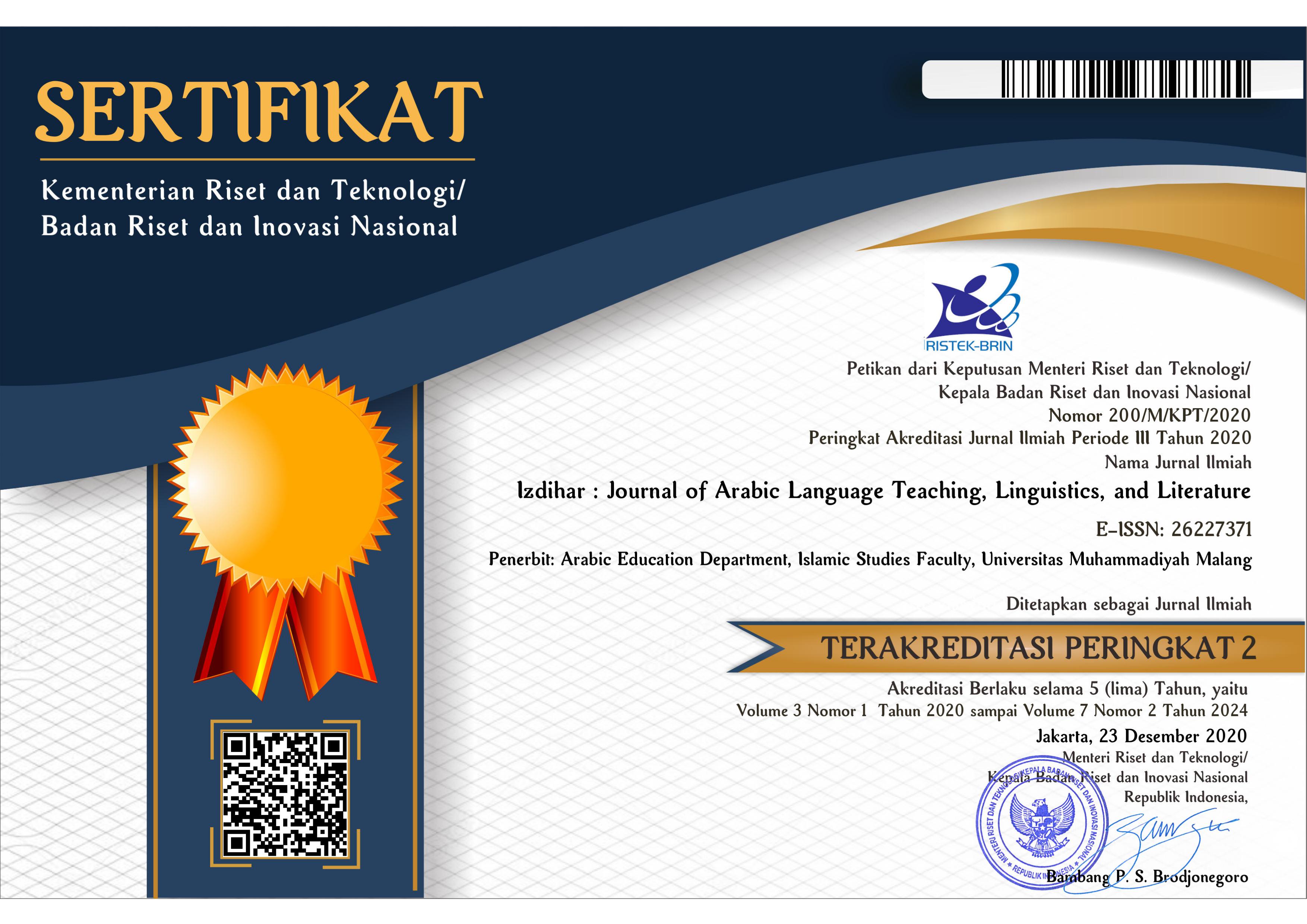Critical Tracing of Arabic Language Acquisition in Indonesian Context
DOI:
https://doi.org/10.22219/jiz.v5i2.20745Keywords:
Arabic Language Acquisition, Phonology, Vocabulary, GrammarAbstract
This study aimed to explore how Arabic phonological, vocabulary, and grammatical are acquired. A qualitative approach was used to deeply explore that acquisition. The results showed that the strategy of acquiring phonological aspects carried out by drilling audio listening activities, either in the form of lectures from native speakers directly or in the form of murottal, Netflix, YouTube, and online radio; while the vocabulary acquisition strategy is done by using an Arabic dictionary both online and offline, as well as reading more books, and news through online portals. Grammatical elements are acquired by directly reading nahwu and shorof books such as Jurumiyyah, Nahwu Wadhih, and Al-arabiyah baina yadaik practicing directly by studying Arabic sentences and practicing I'rab. The findings showed that the language acquisition process using various strategies can provide language acquisition of phonological, vocabulary, and grammatical aspects. Practical implications and further research to explore more diverse variables and more complex research methods are provided.
Downloads
References
Al-amery, A. M. H. (2020). Attitudes of the students at the institutes of fine arts in iraq towards implementing active learning strategies in Arabic Language Courses and the Associated Challenges. Journal of Education and Practice, 11(13), 73–81. https://doi.org/10.7176/jep/11-13-08
Albab, U. (2015). Performansi dan gramatika bahasa Arab sebagai bahasa kedua. ARABIYAT : Jurnal Pendidikan Bahasa Arab Dan Kebahasaaraban, 2(1), 75–85. https://doi.org/10.15408/a.v2i1.1516
Anshari, M. (2018). Akuisisi bahasa Arab pada tataran gramatika dan rasa bahasa bagi pembelajar non Arab. Al-Fathin: Jurnal Bahasa Dan Sastra Arab, 1(01), 61. https://doi.org/10.32332/al-fathin.v1i01.1192
Astuti, W. (2016). Berbagai strategi pembelajaran kosa kata bahasa Arab. Jurnal Komunikasi Dan Pendidikan Islam, 5(2), 178–190.
Useng, A., & Fatmawati, F. (2018). Efektifitas penggunaan media audio visual dalam meningkatkan pembelajaran bahasa Arab siswa kelas VIII SMP Unismuh. Al-Maraji': Jurnal Pendidikan Bahasa Arab, 2(2), 57-73.
Bahruddin, U., & Febriani, S. R. (2020). Implementation of Krashen ’ s theory in language acquisition Stephen. International Journal of Innovation, Creativity and Change, 13(8), 821–831.
Boyd, B., Tahini, I. H., & Dadykin, A. K. (2018). Fundamentals of new effective system to accelerate language acquisition using visual approach. International Journal of Information and Education Technology, 8(11), 768–772. https://doi.org/10.18178/ijiet.2018.8.11.1137
Carter, R., & McCarthy, M. (2014). Vocabulary and language teaching. Routledge. https://doi.org/10.4324/9781315835860
Chafidzoh, T. F. (2020). Strategi meningkatkan pemerolehan bahasa Arab dengan memperhatikan tipe kepribadian siswa. Al-Ma’rifah, 17(1), 48–57. https://doi.org/10.21009/almakrifah.17.01.05
Fahmi, A. K. (2016). Analisis kesalahan gramatikal teks terjemah (Indonesia-Arab) dalam pendidikan bahasa Arab. Kordinat: Jurnal Komunikasi Antar Perguruan Tinggi Agama Islam, 15(1), 105–116. https://doi.org/10.15408/kordinat.v15i1.6311
Gass, S. M. (2018). Modeling second language acquisition 1. Input, Interaction, and the Second Language Learner, 1–30. https://doi.org/10.4324/9781315173252-1
Gleitman, L. R., Liberman, M. Y., McLemore, C. A., & Partee, B. H. (2019). The impossibility of language acquisition (and How They Do It). Annual Review of Linguistics, 5, 1–24. https://doi.org/10.1146/annurev-linguistics-011718-011640
Hamid, M. A., Widayanti, R., Febriani, S. R., Desrani, A., & Yasmadi. (2022). Investigating Arabic foreign learning in indonesian context : It ’ s necesity or it ’ s the demand?. Ijaz Arabi Journal of Arabic Learning, 5(2), 549–562. https://doi.org/10.18860/ijazarabi.v5i2.15059
Hammarberg, K., Kirkman, M., & De Lacey, S. (2016). Qualitative research methods: When to use them and how to judge them. In Human Reproduction (Vol. 31, Issue 3). https://doi.org/10.1093/humrep/dev334
Hidayah, N. (2020). Peluang dan tantangan pemerolehan bahasa Arab Sebagai bahasa kedua (kajian pskolinguistik pada pembelajaran bahasa Arab). Taqdir, 5(2), 65–76. https://doi.org/10.19109/taqdir.v5i2.4922
Hidayat, Y. (2018). Teori perolehan dan perkembangan bahasa untuk jurusan pendidikan bahasa Arab. Maharat: Jurnal Pendidikan Bahasa Arab, 1(1), 24-40. https://doi.org/10.18196/mht.113
Jenny X. Montaño-González. (2017). Learning Strategies in Second Language Acquisition. US-China Foreign Language, 15(8). https://doi.org/10.17265/1539-8080/2017.08.001
Kasanah, & Sauri, S. (2020). Implementasi metode gramatika-tarjamah dalam pembelajaran bahasa Arab di Madrasah Tsanawiyah Futuhiyyah 2 Mranggen Demak. 453–460.
Kosmas, P., & Zaphiris, P. (2020). Words in action: Investigating students’ language acquisition and emotional performance through embodied learning. Innovation in Language Learning and Teaching, 14(4), 317–332. https://doi.org/10.1080/17501229.2019.1607355
Krashen, S. D. (2009). Principles and practice in second language acquisition. in review of educational research (Vol. 33, Issue 1). University of Southern California. https://doi.org/10.3102/00346543033001038
Lüke, C., Ritterfeld, U., Grimminger, A., Liszkowski, U., & Rohlfing, K. J. (2017). Development of pointing gestures in children with typical and delayed language acquisition. Journal of Speech, Language, and Hearing Research, 60(11), 3185–3197. https://doi.org/10.1044/2017_JSLHR-L-16-0129
MacWhinney, B. (2017). First language acquisition. The Handbook of Linguistics, 397–413. https://doi.org/10.1002/9781119072256.ch19
Marlina, L. (2019). Pengantar ilmu ashwat. Fajar Media.
Montrul, S. (2019). How learning context shapes heritage and second language acquisition. The Handbook of Informal Language Learning, 57–74. https://doi.org/10.1002/9781119472384.ch4
Nassaji, H. (2015). Qualitative and descriptive research: Data type versus data analysis. In Language Teaching Research (Vol. 19, Issue 2). https://doi.org/10.1177/1362168815572747
Oliver, R., & Azkarai, A. (2017). Review of child second language acquisition (SLA): Examining theories and research. Annual Review of Applied Linguistics, 37(May), 62–76. https://doi.org/10.1017/S0267190517000058
Pathan, H., Memon, R. A., Memon, S., Khoso, A. R., & Bux, I. (2018). A critical review of Vygotsky’s socio-cultural theory in second language acquisition. International Journal of English Linguistics, 8(4), 232. https://doi.org/10.5539/ijel.v8n4p232
Rahardjo, M. (2020). Metodologi penelitian kualitatif untuk ilmu-ilmu sosial dan humaniora (dari teori ke praktik). Republik Media.
Rodliyah Zaenuddin. (2012). Pembelajaran nahwu dan sharaf dan implikasinya terhadap membaca dan memahami literatur bahasa Arab Kontemporer pada santri Pesantren Majlis Tarbiyatul Mubtadiin Desa Kempek Kecamatan Gempol Kabupaten Cirebon. Holistik, 13(June), 95–120.
Ryoe, P. J. (2020). Pemerolehan bahasa kedua (bahasa Indonesia) pada anak usia 2 tahun. Kajian Bahasa Dan Sastra, 1(1), 274–282.
Schimitt, N. (2000). Vocabulary in language teaching. Cambridge University Press.
Slabakova, R. (2017). The scalpel model of third language acquisition. International Journal of Bilingualism, 21(6), 651–665. https://doi.org/10.1177/1367006916655413
Susanto, Muafiah, E., Desrani, A., Ritonga, A. W., & Hakim, A. R. (2022). Trends of educational technology ( EdTech ): Students ’ perceptions of technology to improve the quality of islamic higher education in Indonesia. International Journal of Learning, Teaching and Educational Research, 21(6), 226–246. https://doi.org/https://doi.org/10.26803/ijlter.21.6.14
Suzuki, Y., Nakata, T., & Dekeyser, R. (2019). Optimizing second language practice in the classroom: Perspectives from cognitive psychology. Modern Language Journal, 103(3), 551–561. https://doi.org/10.1111/modl.12582
Syahid, A. H. (2015). Bahasa Arab sebagai bahasa kedua (kajian teoretis pemerolehan bahasa Arab pada siswa non-native). ARABIYAT : Jurnal Pendidikan Bahasa Arab Dan Kebahasaaraban, 2(1), 86–97. https://doi.org/10.15408/a.v2i1.1797
Downloads
Published
How to Cite
Issue
Section
License
Copyright (c) 2022 Zainul Arifin; Suci Ramadhanti Febriani; Settings Ayu Desrani; Arifka Mahmudi; Kddour Guettaoui Bedra; Izdihar : Journal of Arabic Language Teaching, Linguistics, and Literature

This work is licensed under a Creative Commons Attribution-ShareAlike 4.0 International License.
Copyright Notice
Authors who publish with this journal agree to the following terms:
- Authors retain copyright and grant the journal right of first publication with the work simultaneously licensed under a Creative Commons Attribution-ShareAlike 4.0 International License that allows others to share the work with an acknowledgment of the work's authorship and initial publication in this journal.
- Authors are able to enter into separate, additional contractual arrangements for the non-exclusive distribution of the journal's published version of the work (e.g., post it to an institutional repository or publish it in a book), with an acknowledgment of its initial publication in this journal.
- Authors are permitted and encouraged to post their work online (e.g., in institutional repositories or on their website) prior to and during the submission process, as it can lead to productive exchanges, as well as earlier and greater citation of published work (See The Effect of Open Access).
Copyright (c) 2019 Izdihar : Journal of Arabic Language Teaching, Linguistics, and Literature

This work is licensed under a Creative Commons Attribution-ShareAlike 4.0 International License.

















